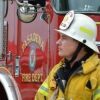Download the FireRescue1 digital edition “Dirty Helmet Syndrome: Are you afflicted?”
Nothing irritates me more than to watch personnel emerge from live-fire training with soot-covered, scorched helmets. And what’s worse – the boasting and comparing of their helmets to see whose helmets suffered the most damage.
This is not a sign of courage but rather one of stupidity!
The radiating heat is sometimes so intense that the helmets actually start to melt. Don’t get me wrong, depending on the fuel load, this can happen. But there is a different side of this situation.
Protect the helmet that protects you
Fire officers, what do you do when you see crews boasting about a melted helmet? Do you take action, or do you join in on the “tough guy talk”?
Here’s how this should play out: When we see such boasting and behavior on the training ground, we must stop the evolutions and conduct a safety briefing with personnel. That’s right. Stop it in its tracks right then and there. Why? Such foolish behavior sets a bad example for the recruits and rookies, and puts everyone in danger.
Personnel must be reminded that our helmets can sustain damage during real fires and even live-fire training, so we need to work to keep them intact for as long as possible – not purposefully rough them up for the sake of looking tough, seasoned or whatever bravado they are trying to display. A damaged helmet is a threat to their safety, both in the short and long term of their career.
Remember what’s happening around you
The temperature in a dwelling fire can rise rapidly, to the point where all flammable materials will become involved in fire, ultimately reaching flashover. If the fire continues to grow due to fuel being introduced to the compartment (flammable gases or liquids, or a large fuel load in the room), temperatures will continue to rise to a point where building components, including steel structural elements, will start to fail. That means your helmet.
Our helmets are made of polycarbonate, which can melt at 450 degrees. Structure fires can reach up to 1,500 degrees, so it will not take much to melt them.
Remember the term Immediately Dangerous to Life or Health (IDLH), defined by NIOSH as an environment that involves exposure to airborne contaminants that are “likely to cause death or immediate or delayed permanent adverse health effects or prevent escape from such an environment.” This includes, but is not limited to, smoke or other poisonous gases at sufficiently high concentrations. And OSHA defines the IDLH environment as “an atmosphere that poses an immediate threat to life, would cause irreversible adverse health effects, or would impair an individual’s ability to escape from these dangerous atmospheric conditions.”
Our PPE is meant to protect us from all of this. Again, that includes your helmet.
Clean your gear
It’s not enough for firefighters to simply protect their helmets during real and training fires. No, firefighters must also protect themselves from the toxins that remain on their helmets after the fire. The byproducts of combustion can produce harmful, cancer-causing particles that permeate your helmet. So if you remove your helmet and hang it back on the shelf without cleaning it, you will be exposed to these particles over and over again.
Remember, it’s not just your helmet that needs care. Your entire protective ensemble needs to be protected and cleaned. Our gear is exposed to toxic substances and when not properly handled and cleaned, the gear just continues to expose us to the off-gassing from the gear. This is also why it’s essential that firefighters have a second set of PPE, so they are always ready to go with a clean set.
PPE Resources
Read everything you need to know about how to properly decontaminate your gear here
Jeffrey and Grace Stull tackle all facets of PPE cleaning and decontamination.
Put policies in place
Departments must educate their personnel on proper PPE cleaning. There are countless resources available for this. But to ensure such cleaning actually happens, departments must work the cleaning expectations into their policies and procedures.
NFPA 1851: Standard on Selection, Care, and Maintenance of Protective Ensembles for Structural Fire Fighting and Proximity Fire Fighting is a good place to start. The standard previously required fire departments to conduct advanced cleaning of PPE at least once a year. It also stated that clothing should actually be cleaned whenever it is soiled or contaminated. However, the 2020 edition of NFPA 1851 states two advanced cleanings are now required each year, and protective clothing should be subject to advanced cleaning whenever it is exposed to products of combustion (e.g., fire gases and smoke particulates).
Beyond meeting NFPA standards, fire departments should implement their own policies related to frequency and type of post-incident decontamination. Having this spelled out in policy should eliminate the opportunity for debate – it’s just how firefighters must treat their gear.
Make it a group effort
Keeping firefighters safe and healthy is both an individual and group effort. Each individual firefighter must take ownership of their health and safety, but it’s everyone’s responsibility to look out for each other as well. And a safety focus impacts every member of the team.
For example, during real incidents, dispatchers should provide the incident commander time intervals to let them know how long personnel have been inside and/or exposed to heat, fire and smoke. Safety officers need to be in place, but remember, everyone is a safety officer. If you feel conditions becoming untenable, say something!
Look to the future
The “I am tougher than you” bravado has got to go. It is NOT a badge of honor or courage to have a scorched or melted helmet or dirty PPE – it reflects foolish irresponsibility. It’s time to put the days of dirty PPE and damaged helmets in the rear-view mirror so we can look ahead to a long and healthy career and retirement.





